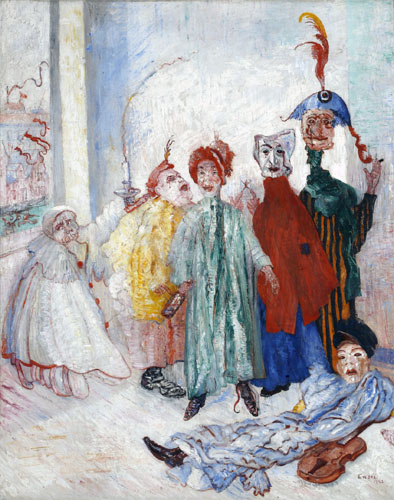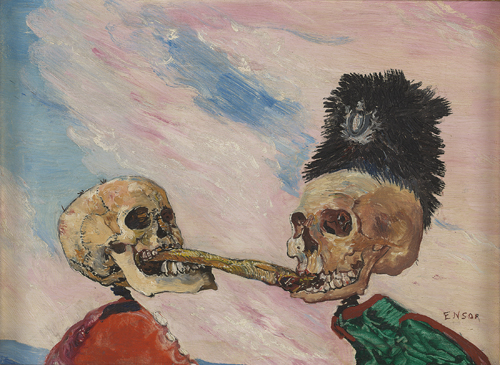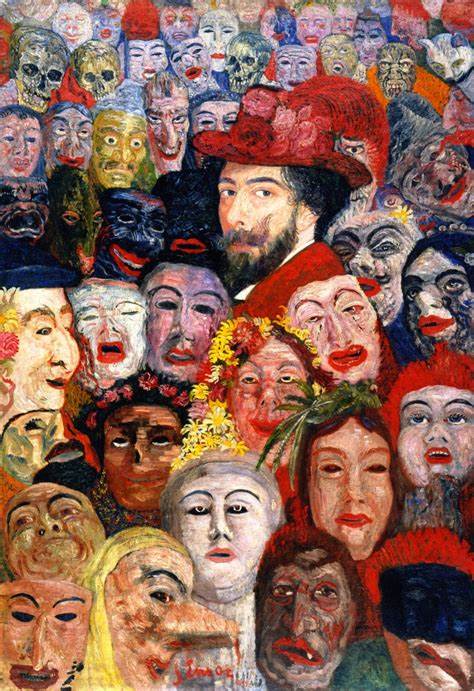5 Expressionist Artists You Should Know
The purpose of art for a group of avant-garde individuals at the turn of the 20th century was no longer the realistic rendition of the natural world,...
Guest Profile 29 February 2024
Do you know who James Ensor was? James Ensor (1860-1949) was a scandalous, rebellious, and revolutionary Belgian painter with a style that could be described as something in-between Impressionism and Expressionism. On the occasion of his birthday, we dive into the fantastic world of James Ensor, where the comical, the distressing, and the terrifying meet.
James Ensor (1860-1949) was a Belgian expressionist painter and promoter of avant-garde trends, known for his mysterious and enigmatic works of masked characters and satirical scenes. Although he is mostly known for his surrealistic scenes of grotesque and carnivalesque characters, Ensor’s pictorial beginnings were rather academic. Ensor abandoned his studies at the early age of 15 to begin training with local painters. Subsequently, he trained at the Royal Academy of Fine Arts of Belgium in Brussels.
Thus his early works (1879-1882) are characterized by a realistic style, using sober and restrained colors with a melancholic touch. From this period, themes such as bourgeois interiors, everyday subjects, and still lifes stand out.
Starting in 1885, we can see a clear second stage in Ensor’s work. In this period the themes acquire a more surreal, symbolic, and fantastic dimension. At the same time, this could be called a colorist period, in which the vivid and bright colors contrast with the horrendous and grotesque scenes.
A multitude of characters such as skeletons, puppets, and above all, masks invade Ensor’s canvases. Ridiculous, comical, and at the same time frightening beings painted with oversaturated, unrealistic colors and cartoonish make-up appear in a sort of carnival.

James Ensor, The Death and the Masks, 1897, private collection. Wikimedia Commons (public domain).
Masks would become a constant in Ensor’s works. Inspired by the carnival masks in his mother’s gift shop, he understands the mask as an instrument of “expressionistic demasqué”. The mask is understood as an instrument that covers the face but it reveals human ugliness. These carnival elements serve the Belgian painter as a metaphor to precisely “unmask” society. A society that he considers hypocritical and false. Thus, through the masked characters of his work, he performs a “demasqué” an act through which he reveals the true malicious and ridiculous nature of humans.

James Ensor, Singular Masks, 1892, Musées Royaux des Beaux-Arts de Bélgique, Brussels, Belgium.
Ensor also frequently addresses death and art itself. In Skeletons Fighting over a Herringbone, with his usual irony, Ensor depicts two art critics of his time through the skeletons, which symbolize the death of art. The dead herring they dispute would be the artist himself, harshly attacked for his rebellious style.

James Ensor, Skeletons Fighting over a Herringbone, 1890, Musées Royaux des Beaux-Arts de Bélgique, Brussels, Belgium.
Another constant element in Ensor’s painting is the mass, the crowd. In the famous work Self-Portrait with Masks, we see a multitude of masked figures, empty and dehumanized individuals represented with saturated colors and caricatured makeup. In the midst of this “horror vacui” Ensor portrays himself in the style of his Flemish compatriot and great master Peter Paul Rubens. Thus he too is disguised, but his face is uncovered, fleeing from the hypocrisy of the masses.

James Ensor, Self Portrait with Masks, 1889, Menard Art Museum, Aichi, Japan.
Although in the early days James Ensor shocked his contemporaries and provoked with his art, eventually critics recognized his oeuvre. In 1929 he received the title of Baron from King Albert I and in 1933 he was decorated with the band of the Legion of Honor, thereby establishing himself as one of the most important Belgian painters of all time.
DailyArt Magazine needs your support. Every contribution, however big or small, is very valuable for our future. Thanks to it, we will be able to sustain and grow the Magazine. Thank you for your help!